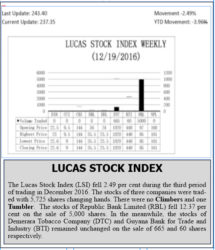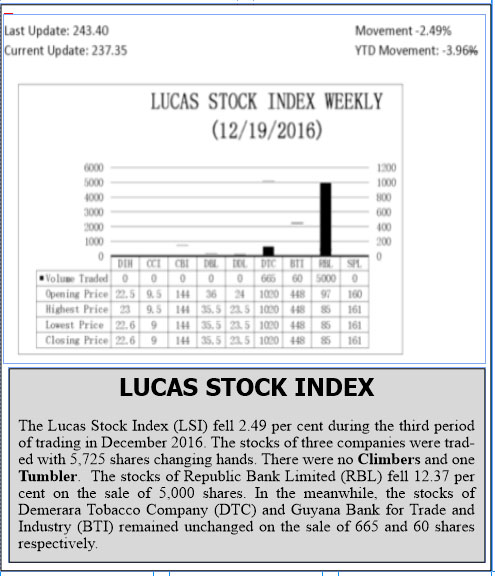Continued attention and support
In last week’s article, I indicated the reason that low-income workers appeared unenthusiastic about the relief that the 2017 budget has brought them. It was explained that their economic circumstances, though much improved from previous years, were still difficult and they would need continued attention and support. Their purchasing power is below their needs and they will have to continue to survive as best as they can. The article ended by observing that high-income earners would be better off than those falling between the two groups, particularly those earners who fall into the new marginal tax bracket of 40 per cent. Where income tax is concerned, it is the group that is earning $163,650 to $250,000 that would see the highest increases in their tax liability. In this final part of the article, an examination will be made of the likely impact of various taxes on the personal incomes of workers in the abovementioned income category and the economy as a whole.
Share of burden
In looking at the situation of the income group referred to above, the persons who were earning between $163,650 and $180,000 must regret ever receiving the salary increases that they got. The truth is whenever adjustments are made to the income tax structure a group of workers is made to bear an unfair share of the burden. Last year when salaries increased, some of the workers who were earning just below the exemption amount found themselves paying taxes for the first time. Things looked unfair then, but would have been regularized for most of them with the adjustment to the exemption threshold in 2016 and that proposed for 2017. For persons earning at the lower end of the income range stated above, the 10 per cent salary increase could bring no joy since it takes them into the 40 per cent marginal tax range. They would have been given no opportunity to celebrate receipt of the higher income. The effective tax rate for this group of workers has risen by nine percentage points. A similar feeling of remorse must be facing the persons who received the six percent salary increase from $170,000. This increase carries them also into the new marginal tax rate of 40 per cent and has caused their effective tax rate to increase by eight percentage points.
Disaffected
As a consequence, this group of income earners is most likely to feel disaffected by the changes in the income tax structure and the 2017 budget. When the concerns of this group are added to those of the low-income workers, it would appear as if the budget did not reach out enough to workers. This situation has given rise to the notion that the government gave benefits with one hand and took them away with the other. The issue for most such taxpayers is whether or not the adjustments were sufficient to distribute the burden of the tax equitably between all income categories. Just as important as the effective tax rate is the impact that the higher rates or charges have on the economy.
Not compulsory
Beyond the income tax, a variety of other taxes are involved. Some affect the quantity of goods and services that could be gotten with the disposable income that households would have in 2017. The principal element of the tax structure is the value-added tax. Others relate to the benefits that taxpayers get for buying certain goods and services from the government. In this latter case, the goods and services include things like passports, driver’s licences, shop licences and other such products or services. One should not ignore them, for while the taxes are not compulsory, they are essential to the conduct of business. They therefore shape the attitude of investors and how they would respond to the taxes.
Persons who buy those goods and services have been forming their own opinions about the increase in fees. Many have concluded that the fee increase for things like passports, vehicle registration licences and liquor licences was not influenced by inflation alone. The fee increases were seen as too steep to be explained by a desire to bring prices in line with current recovery costs. For those persons, the question is whether or not the service that they get from the government is worth the money that they pay for the service. Naturally, taxpayers will be looking for far better service from government departments with the new fees proposed in the 2017 budget.
Incidence of tax
One of the things that is often discussed when taxation is involved is the incidence of the tax.
This refers to who bears the burden of any taxes imposed. Typically, the burden is distributed between the two key groups that make up the private sector, households and businesses. One has also got to acknowledge the role that the government plays in the exchange of goods and services. The conflict is not that simple in an economy like Guyana’s since participants in the market where some of the taxes occur include important public sector entities like Guyana Power and Light and Guyana Water Inc.
The incidence of the VAT has been the subliminal message of all the public comments that have been made about the budget. To discuss this issue with reason, one has got to segregate the taxpayers into three parts, namely the low-income, the middle-income and the high-income.
The discussion has already shown that the low-income workers with insufficient income at hand obviously spend all of their money. They are unlikely to change their behaviour because they have nothing to lose. Further, since the only tax that will affect them is the VAT, and VAT has been lowered, spending by this category of workers will not be adversely affected. They can be expected to continue carrying the burden.
Despite being made to carry a higher share of the income taxes, persons in the middle-income bracket should have enough money to continue meeting their expenditure needs. For them, much depends on the price elasticity of the products that they buy. Judging from the additional income required to make the low-income workers better off, the same conclusion could be drawn for the high-income earners. They too would be able to meet their expenditure needs and one could expect very little change in their spending.
Wider economy
The wider economy could be affected adversely through another economic mechanism. The reduction in disposable income would be most likely to affect the level of personal savings by the middle and high-income taxpayers. This represents the first challenge to the economy. Personal savings are normally used for investment purposes. Households put their money in the bank or they might purchase shares in the stock market. The money that goes into the banks could also be borrowed by someone to engage in direct investment. Either way, savings play a big role in private investment and lower amounts available for deposit mean that the price of money could rise. In the first instance, banks would have to raise their interest rates to attract into their deposits the reduced amount of money in circulation.
With the amount of loanable funds in decline, the banks would have to increase their lending rates. One noticed too that the amount of non-performing loans has been increasing which means that banks would be likely to insist on more stringent lending conditions.
The combined effect of stringent lending conditions and a decline in loanable funds could result in higher cost of funds. Since the price of money would rise for the private direct investor, the price of goods and services would most likely increase as well. Clearly, one or the other, or both, would be likely to produce adverse effects for the economy. Either way, the reduction in disposable income could lead to a loss in national welfare.
Fastest increase
This observation is not a theoretical one. The level of consumer spending is something that one must always take into account when addressing the Guyana economy. In Guyana, consumer spending accounts for over 60 per cent of gross domestic product. This means that spending by households leads to the fastest increase in GDP. Anything that interferes with that speed would have an adverse effect on the economy.

Broader effort
Government’s role is to create an enabling environment for the private sector to flourish. Creating the enabling environment is not only about providing subsidies and other incentives. It is also about ensuring that obstacles do not necessarily stand in the way of the success of the private investor. There is need for public institutions to work well and effectively. It is also about enabling private initiative to do things better and faster. It is also about enabling private investors to be competitive. These institutional weaknesses that the 2017 budget seeks to modify should not be ignored. They are important to improving competitiveness. However, it should be kept in mind that as broad an effort as possible is needed to expand the Guyana economy. This writer expects this broader effort will reveal itself throughout 2017.
It is with that optimistic outlook that I seek to wish all Guyanese, especially readers of the Sunday Stabroek Business Page, a Merry Christmas.







